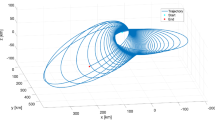Abstract
We describe a semi-analytical averaging method aimed at the computation of the motion of an artificial satellite of the Moon. In this paper, the first of the two part study, we expand the disturbing function with respect to the small parameters. In particular, a semi-analytic theory of the motion of the Moon around the Earth and the libration of the lunar equatorial plane using different reference frames are introduced. The second part of this article shows that the choice of the canonical Poincaré variables lead to equations in closed form without singularities in e = 0 or I = 0. We introduce new expressions that are sufficiently compact to be used for the study of any artificial satellite.
Similar content being viewed by others
References
Bills, B. G. et Ferrari, A.: 1980, 'A Harmonic Analysis of Lunar Gravity', J. of Geophys. Res. 85, 1013–1025.
Broucke, R. A.: 1970, 'On the Matrizant of the Two-Body Problem', Astron. Astrophy., 6, 173–182.
Brouwer, D. and Clemence, G. M.: 1961, Methods of Celestial Mechanics, Academic Press.
Brumberg, V., Evdokimova, L., and Kochina, N.: (1971), 'Analytical Methods for the Orbits of Artificial Satellites of the Moon', Celest. Mech. 3, 197–221.
Chapront, J. and Chapront-Touzé, M.: 1982, 'Tables simplifiées du mouvement de la lune issues de elp-2000', Notes scientifiques et techniques, Bureau des Longitudes.
Deprit, A.: 1969, 'Canonical Transformation Depending upon a Small Parameter', Celest. Mech. 1, 12–30.
Deprit, A. and Rom, A.: 1970, 'The Main Problem of Artificial Satellite Theory for Small and Moderate Eccentricities', Celest. Mech. 2, 166–206.
Eckhart, D. H.: 1981, 'Theory of the Libration of the Moon', The Moon and the Planets, 21, 3–49.
Giacaglia, G., Murphy, J., and Felsentreger, T.: 1970, 'A Semi-Analytical Theory for the Motion of the Moon', Celest. Mech. 3, 3–66.
Laskar, J.: 1989a, 'Manipulations des séries'. In Les Méthodes Modernes de la Mécanique Céleste(Bénest and Froeschlé eds.), pages 89–107, Editions Frontières.
Laskar, J.: 1989b, 'Systèmes de variables et éléments'. In LesMéthodes Modernes de la Mécanique Céleste(Bénest and Froeschlé eds.), pages 63–88, Editions Frontières.
Milani, A. and Knežević, Z.: 1995, 'Selenocentric Proper Elements: A Tool for Lunar Satellite Mission Analysis', Technical Report, European Space Agency, European Space Research and Technology Centre (ESTEC), the Netherlands.
Oesterwinter, C.: 1970, 'The Motion of a Lunar Satellite', Celest. Mech. 1, 368–436.
Osácar, C., Palacián, J., and Palacios, M.: 1995, 'Numerical evaluation of the dilogarithm of complex argument', Celest. Mech., 62, 93–98.
Roy, A.: 1968, 'The theory of the motion of an artificial lunar satellite', Icarus 9, 82–162.
Steichen, D.: 1998, 'An Averaging Method to Study the Motion of Lunar Artificial Satellites: Averaging and applications', Celest. Mech.this issue.
Author information
Authors and Affiliations
Rights and permissions
About this article
Cite this article
Steichen, D. An averaging method to study the motion of lunar artificial satellites I: Disturbing Function. Celestial Mechanics and Dynamical Astronomy 68, 205–224 (1998). https://doi.org/10.1023/A:1008279908543
Issue Date:
DOI: https://doi.org/10.1023/A:1008279908543



